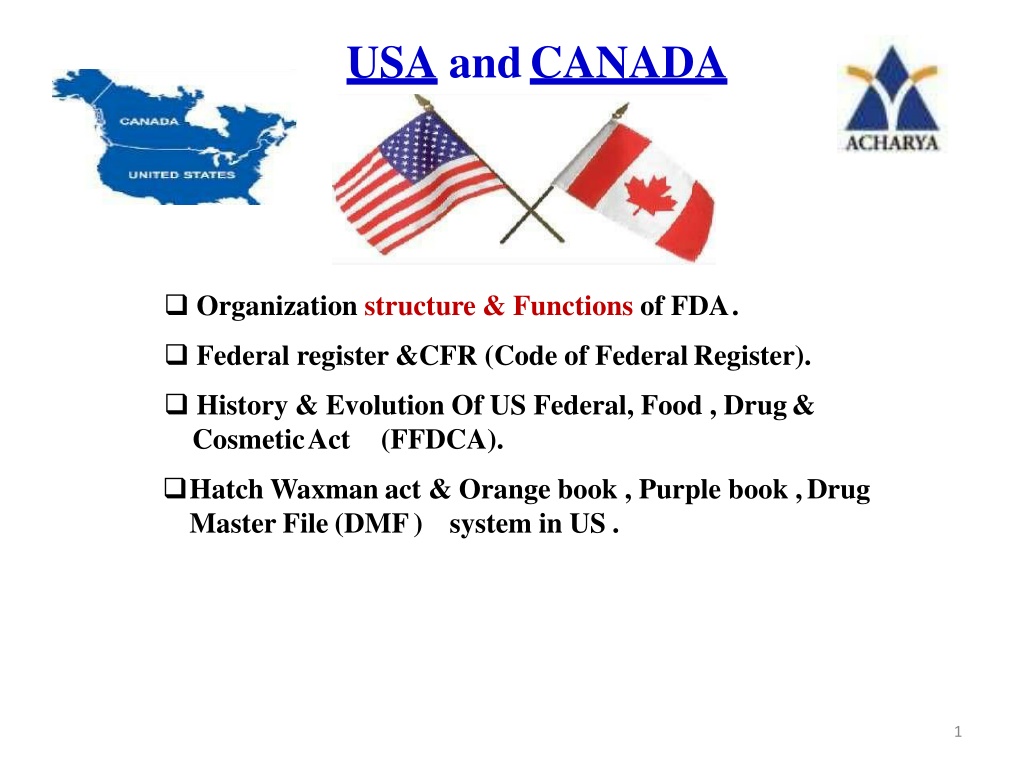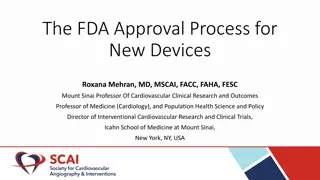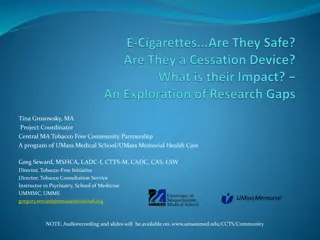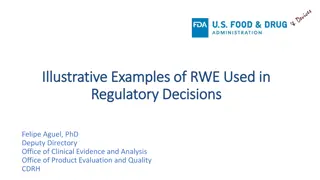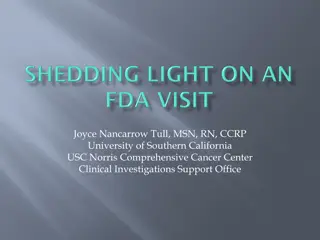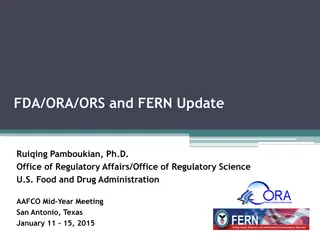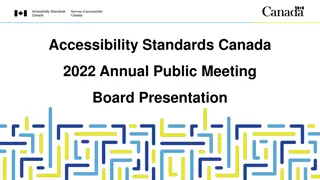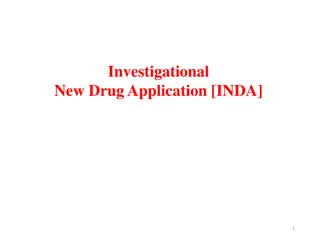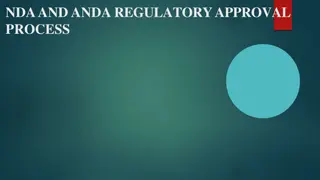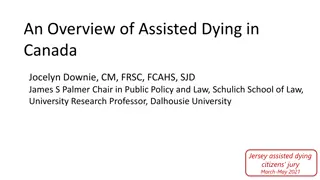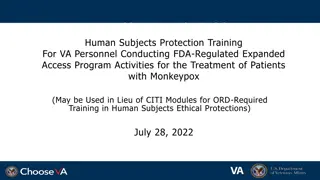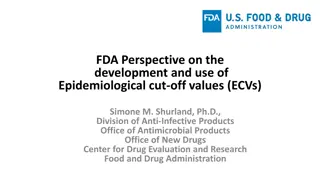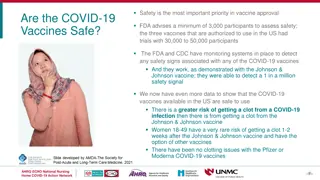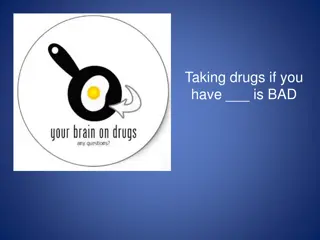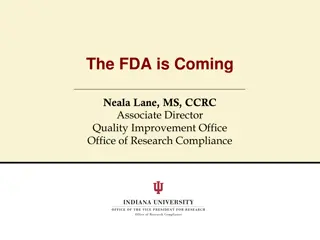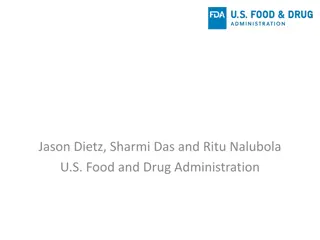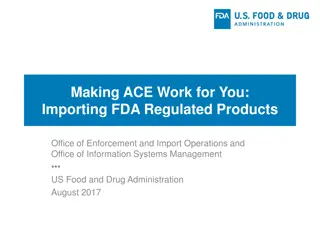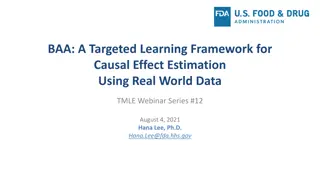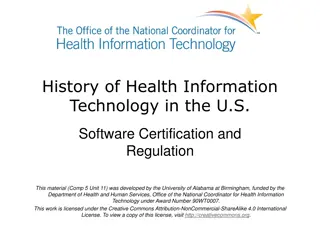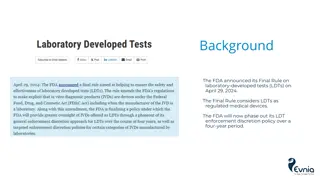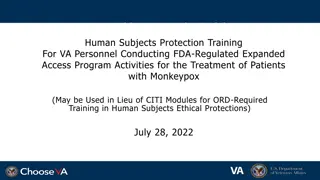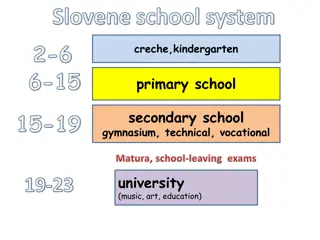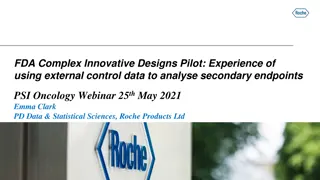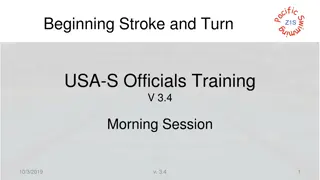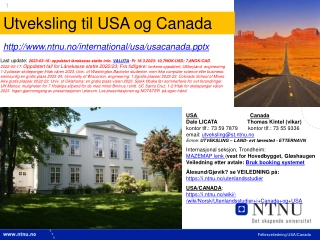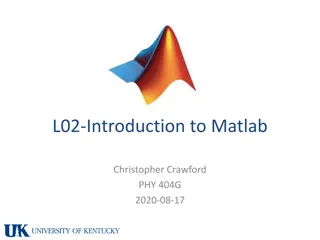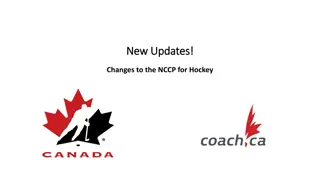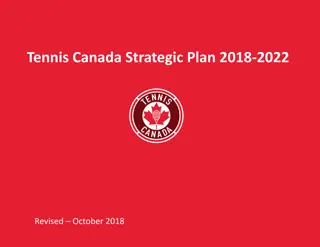Understanding the Structure and Functions of FDA in the USA and Canada
The Food and Drug Administration (FDA) in the USA is a critical agency within the Department of Health and Human Services responsible for regulating the safety of various products such as foods, drugs, medical devices, and cosmetics. The FDA has distinct organizational units like the Office of the Commissioner, Centers for Drug and Biologics Evaluation, and Research, along with specific responsibilities in evaluating and ensuring the safety of different product categories. This organization's history, evolution, and key functions are essential in understanding the regulatory landscape in the USA and Canada.
Download Presentation

Please find below an Image/Link to download the presentation.
The content on the website is provided AS IS for your information and personal use only. It may not be sold, licensed, or shared on other websites without obtaining consent from the author. Download presentation by click this link. If you encounter any issues during the download, it is possible that the publisher has removed the file from their server.
E N D
Presentation Transcript
USA and CANADA Organization structure & Functions of FDA. Federal register &CFR (Code of FederalRegister). History & Evolution Of US Federal, Food , Drug& CosmeticAct (FFDCA). Hatch Waxman act & Orange book , Purple book ,Drug Master File (DMF) system in US . 1
COUNTRY REGULATORYBODY 1. United States Of America(USA) - Food and Drug Administration (FDA) 2. Canada Health Canada 2
FDA Organization, FDA is an agency withinthe Department of Health and Human Services. It is responsible for regulating and supervising the safety of foods , dietary supplements, drugs , vaccines , biological medical products , blood products, medical devices , radiation emitting devices , Veterinary products , and Cosmetics. . The FDA has its Headquarters at White oak ,Maryland. The agency also has 223 field officers . 13 Laboratories located throughout the 50 states. The united states Virgin Islands , and Puerto Rico . 3
FDA - ORGANIZATIONS 1. The Office of the Commissioner (OC) 2. The Center for Drug Evolution and Research ( CDER) 3. The Center for Biologics Evolution and research ( CBER) 4. The Center for Foods Safety and Applied Nutrition (CFSAN) 5. The Center For Devices and Radiological Health ( CDRH) 6. The Center For Veterinary Medicine ( CVM ) 7. The National Center For Toxicological Research ( NCTR) 8. The Office of Regulatory Affairs ( ORA) 4
FDA Center Areas of Responsibility 1. Center for Drug Evaluationand Research Safety and effectiveness of Rx and over the counterdrugs 2.Center for Biologics Evolutionand research Safety and effectiveness of Vaccines , nations blood supply , otherbiologics 3.Center For Devices and Radiological Health Safety and effectiveness of medical devices , diagnostic tests , radiation emittingdevice 4.Center for Foods Safety and Applied Nutrition Safety of domestic and importedfood supply . Cosmetic dietarysupplement 5.Center For VeterinaryMedicine Safety and effectiveness of Veterinary drugs Implementation of the Familysmoking prevention and Tobacco Controlact Research to support regulatory decisions and reduce risks associated with FDA regulatedproducts 6.Center For Tobaccoproducts 7.National Center ForToxicological Research 8.Office of RegulatoryAffairs Enforcement of laws and regulations 5
Responsibility of US FDA FDA is responsible for protecting the public health by assuringthe Safety , efficacy and security of human and veterinary drugs, Biological products , medical devices , Us nation foodsupply Cosmetics and products that emit radiation . FDA is also responsible for advancing the public health: 1 . By helping to speed innovations that make medicines moreeffective safer and more affordable. 2 . By helping the public get the accurate , science based information they need to use medicines & foods to maintain and improve theirhealth 7
FUNCTIONS OF US FDA FDA has 4 Roles: 1 . To promote health by reviewing research and approving new products . 2. To ensure foods and drugs are safe and properly labeled . 3. To work other nations to reduce the burden of regulation . 4. To cooperate with scientific experts and consumers to effectively carry out these obligations . 8
US FDA REGULATES: Foods , expect for most meat and poultry products , which are regulated by the U.S. Department of Agriculture. Food additives Infant formulas , Dietary supplements Human drugs Vaccines , blood products , and other biologics Medical devices , from simple items like tongue depressors , to complex technologies such as heart pacemakers . 9
US FDA REGULATES: Electronic products that give off radiation , such as microwave ovens and X ray equipment . Cosmetics Feed , drugs , and devices used in pets , farm animals , and other animals. Tobacco products . US FDA Doesn't regulates: Advertising (except for prescription drugs, medical devices , and tobaccoproducts). Alcoholic beverages Some consumer products , such as heroin and marijuana. Health insurance . Meat and poultry ( Except for game meats , such as venison , ostrich , and snake ). Restaurants and grocery stores 10
FEDERAL REGISTER: The federal register is the official journal of the federal government of the United States that contains government agency rules , purposed rules , and public notices It is published daily , except on federal holidays . The final rules promulgated bya federal agency and published in the Federal register are ultimately recognized by topic or subject matter and codifiedin the Code of Federal Regulations ( CFR ) . It is updated annually . 11
CODE OF FEDERAL REGULATIONS(CFR) Is the codification of the general and permanent rules and regulations (administrative law ) published in the federal register by the executivedepartments and agencies of the federal government of the united states. The CFR is divided into 50 titles that represents broad areas subject tofederal regulation . The CFR annual edition is the codification of the general and permanent rules published by the office of the Federal register ( part of the National Archivesand records administration ) and the government publishing office . In addition to this annual edition , the CFR is published in anunofficial format online on the electronic CFR website which is updateddaily 12
THE CODE OF FEDERAL REGULATIONS Content s Discipline : Administrativelaw Language : English Publication Details Publisher : Office of the federal Register Frequency : Annually (United states) License : Publicdomain Standard abbreviations Blue Book : C.F.R. ISO 4 :Code of federal Regulations Indexing ISSN : 1946 4975 Links Journal homepage , Onlineaccess. 14
INTRODUCTION OF UNITED STATESFEDERAL, FOOD , DRUG AND COSEMETIC ACT (FFDCA) The Introduction of this act was influenced by the death of more than100 patients . Due to a sulfanilamide medication where di ethylene glycol was used to dissolve the drug and make a liquid form ( see elixir sulfonamidedisaster) It replaced the earlier Pure Food and Drug Act Of 1906 ]. 15
HISTORY AND EVOLUTION OF UNITED STATESFEDERAL, FOOD , DRUG AND COSEMETIC ACT (FFDCA) The United States Federal Food , Drug , Cosmetic Act 1938. (abbreviated as FFDCA , FDCA or FD&C), Is a set of laws passed by congress in 1938 giving authority to the U.S. Food and Drug Administration (FDA) to oversee the safety of food , drugs ,and Cosmetics. A Principal author of FDA from New york law was Royal S. Copeland , a three term senator 16
HISTORY AND EVOLUTION OF UNITED STATES FEDERAL, FOOD , DRUG AND COSEMETIC ACT (FFDCA) In 1968 , the electronic product Radiation Control provisions were added to the FD&C . Also in the year 1968 the FDA formed the new program Drug Efficacy Study Implementation ( DESI ) . DESI to incorporate into FD&C regulations the recommendations from a National Academy Of Sciences. DESI mainly deals investigation of effectiveness of previously marketed drugs . The act has been amended many times , most recently to add requirements about bioterrorism preparations . 17
FEDERALFOOD , DRUGAND COSMETICACT (FFDCA) LONG TITLE: To prohibited the movement in interstate commerce of adulterated and misbranded food , drugs, devices, and cosmetics, and for other purpose . Acronyms(Colloquial) FFDCA , FD&C Act Enacted by the 75 th united state congress . Citations Public Law 75 717 Statutes at Large 52 stat . 1040 18
Codification Acts replaced Pure Food and DrugAct Titles amended 21 U.S.C. : Food and Drugs U.S.C sections created 21 U.S.C. : Food andDrugs U.S.C sections created 21 U.S.C c h 9 s s 301 et.seq. Legislative History Introduced in the senate as S. 5 by Royal Copeland (D-NY)on January 6, 1937 Passed the Senates on March 9 , 1937(Voice) Passed the house with amendment on June 1 , 1938 (Voice) Reported by the joint conference committee on June 10 , 1938 : agreed to by the senate on June 10 1938 (voice) and by theHouse on June 13, 1938 (voice) Signed into law by President Franklin D . Roosevelt on June 25, 1938 . 19
Majoramendments 1951 Food , Drug , and Cosmetics act amendments , PL 82 215 , 65 stat648 1962 Food , Drug , and Cosmetic act amendments, PL 87 781 , 76 stat780 Fair Packaging and Labeling Act , PL 89 755 80 stat 1296. Medical Device Regulation act , PL 94 295 , 90 stat 539. Radiation control for safety and health act , PL 90 602 , 82 stat 1173. Drug price Competition and Patent term Restoration Act of 1984 , PL 98 471,98 stat 1585 . Nutrition Labeling and education act ( 1990) PL 101 535 , 104 stat2353) 20
Majoramendments Safe medical device Amendment of 1990, Pl 101 629 , 104 Stat 4511. Food and Drug Administration Revitalization Act (1990) , PL 101 635 ,104 Stat 4583. Dietary Supplemental Health Education Act (1994) , PL 103 417 , 108 Stat 4332 . Food Quality Protection Act of 1996 . Food and Drug Administration Modernization Act of 1997 , PL105 115 Stat 2296. Food and Drug Administration Amendments Act 2007 , PL 110 -85 , 121 Stat 8231 21
HATCH WAXMANACT INTRODUCTION 1962 Proof of efficacy made compulsory for marketing approval of a new drug. By (Kefauver Harries Amendments) Before 1962 new drug approved based on safety alone . In 1984 HATCH WAXMAN ACT enacted HATCH WAXMAN ACT also Known as The Drug Price Competition andPatent Term RestorationAct Amended in the patent laws . Amended the Federal food , Drug , and Cosmetics Act. There was no provision for patent term extension prior to enactment. Hatch Waxman Act , to make up for time lost out of the total patent termduring the marketing approval process . 22
Generic companies required to submit their own comprehensiveNDA Costly Time consuming If Drug was Covered by patent testing could not begin until patent expired . To Overcome the above problems on act was needed to promote generic companies. OBJECIVES OF HATCH WAXMANACT Reducing the cost associated with the approval of a generic drug. Allowing early experimental use. Compensating the branded drugs manufacturers for the time lost fromthe patent term because of the regulatory approvalformality Motivating the generic drugmanufacturers HATCH WAXMAN ACT strike a balance between the interestsof branded drug manufacturers , generic drug manufacturers and the consumers 23
PROVISIONS OF HATCH WAXMANACT Creation of section 505 (j). Section 505 (j) established the ANDA (Abbreviated new drugapplication) approval for an existing licensed medication / approved drug process. The limiting of an ANDA approval depends in part on patent protections forthe innovator drug . NDA ( New Drug Application)must include any patent the claims the drug or a method of using ( the ) drug or a method of using (the ) drug for which a claim of patent infringement could reasonably be asserted. On approval of NDA , FDA publishespatent information for drug in Orange Book ( Approval drug products with Therapeutic EquivalenceEvolutions) 24
ORANGE BOOK FDA publishes patent information on approved drug products in the orangebook An NDA( new drug application ) applicant must submit the following information for each patent : Patent no and date on which the patent will expire Type of patent . i e . Drug , drug product , or method of use Name of the patent owner The name of an agent of the patent owner of applicant Brand Drugs Listed for generics to compare with their purposedproducts 25
ORANGE BOOK The publication Approved Drug Products with Therapeutic EquivalenceEvolutions Commonly known as Orange book . Identifies the drug products approved on the basis of safety and effectivenessby the Food and Drug Administration (FDA) under the Federal Food , Drug , and Cosmetic Act ( the act ) and related patent and exclusively information. Formally called Approved Drug Products with Therapeutic EquivalenceEvolutions. Orange book does not include drugs only approved as safe . Drugs whose safety or efficacy approval has been withdrawal are also is excluded from the Orange book . A drug that is currently subject to regulatory action may still appear in theorange book . 27
THE ORANGE BOOK CONSISTS OF 4PARTS The orange book is composed of the following 4 parts : Approved prescription drug products with therapeutic equivalenceevolutions Approved OTC (over the counter ) drug products for those medications thatmay not be marketed without new drug applications or ANDs (abbreviated new drug application ). Because they are not covered under existing OTC monographs : drug products administered by the center for biologics evolution and research anddiscontinued products . Drug Products with a codes are considered to be therapeutically equivalent . Those with B code drugs ( requires further FDA investigation and review )are not therapeutically equivalent . 28
PURPLE BOOK Lists Of Licensed Biological Products With Reference Product Exclusivity and Bio similarity or Interchangeability Evolutions . The Purple book Lists biological products , including any bio similar and interchangeable biological products , licensed by FDA under the publichealth Service Act ( the PHS Act). The Purple book includes the data a biological products was licensed under 351(a) PHS (Public health service act ). Whether FDA evaluated the biological product for reference productexclusivity under section 351 (k) (7) of the PHS (Public health service) act . 29
PURPLE BOOK The purple book in addition to the date licensed , also includes whether abiological product licensed under section 351 ( k) of the PHS (Public healthservice)act. PHS (Public health service) has been determined by FDA to be bio similar to or interchangeable with a reference biological product ( an already licensed FDA biological product ) . The Patent Protection Act and Affordable Care Act (Affordable care act ) ,Signed into law by President Obama on March 23, 2010 . Amends the PHS act to create an abbreviated licensue pathway for biological that are demonstrated to be Bio similar to or inter changeable with an FDA licensed biologicalproduct. 30
PURPLE BOOK This pathway is provided in the part of the affordable care act Known as the BPCI Biological Price competition and Innovation Act at 2009. Bio similar and inter changeable biological products licensed under section 351 (k) of the PHS (Public health Service) act . PHS (Public health Service) act will be listed under the referenceproduct to which bio similarity or inter changeability was demonstrated. Healthcare provides can prescriber bio similar andinterchangeable biological product just as they would prescribe other medications. The BPCI act Describes an inter changeable product as a product thatmay be substituted for the reference product. 31
In contrast , FDA experts that a bio similar product will be specificall prescribed by the healthcare provider and cannot be substituted for a reference product at the pharmacy level separate lists for those biological products regulated by the y CENTER FOR DRUG EVALUTION AND RESEARCH (CDER ) and CENTER FOR BIOLOGICS EVALUATION ANDRESEARCH (CBER) will be updated periodically . 32
DRUG MASTER FILES ( DMF ) inUS A Drug Master file (DMF) is a confidential , detailed document submittedby Active Pharmaceutical Ingredient (API) API manufacturers to the U.S. Food and Drug Administration (FDA) A Drug Master File contains the chemistry , manufacturing , and controls of adrug component . A DMF required to supply bulk materials to the United States , butthe FDA does not require all manufactures to submit a DMF may be used to supportan Investigational New Drug Application (IND), a New Drug Application ( NDA) An Abbreviated New Drug Application (ANDA), another DMF , anExport Application , or related documents . 33
The FDAsays a DMF cannot be substituted for an IND , NDA,ANDAor Export application . It is not Approved or disapproved , according to the FDA. Technical Contents of a DMF are reviewed only in connection with the reviewof an IND , NDA,ANDAor an ExportApplication . API manufactures with a large number of DMF s are often considered more reliable in terms of Quality , regulatory standing , and ability to meet Current good manufacturing Process (c GMP ) requirements. Before DMFs Can be reviewed , a manufacturer must submit a dose form filling that references the DMF . 34
Not all DMF s are reviewed by the FDA , and the possessions of a DMFfor a product does not ensure that a manufacturer is producing that product or able to supply it to the United States. In the Past , Filling a DMF was a way for less established firms to claim a degree of creditability when trying to sell into the U.S.markets. However , since DMF s are only reviewed when an ANDA or NDA references them , a DMF that has not been reference is ofquestionable value even if the DMF holder thinks having a DMF makes them look legitimate . Filling the DMF s without any Customers in the U.S. has becomemuch less common , so more recent DMF s are better indicator of intent to manufacture than older DMF s. 35
TYPES OF DMFs The Five Types Of DMFs TYPE I DMFs : Manufacturing site , facilities, operating procedures and personal not specific toa drug substance . Type I DMFs are no longer accepted by the FDA , but old ones remain same. TYPE II DMF s : Drug Substances , substance intermediates , and materials used in their preparation or a drug product . A type II DMF s , the most common form , can also cover dosage form drugs manufactured under contract for another company which would file an ANDA. TYPE III DMF s : Packing materials , form bottles and caps to PVC resin used in their manufacture must be covered in a DMF or other FDA document such as an NDA. 36
TYPE VI DMF s: s Excipient , flavor , essence or material DMF . Excipients are chemically inactive substances such as starches or cellulose usedto bind drug powder together so that it can be pressured into a tablet . Other examples include flavorings in children's drugs , alcohol in liquids , etc. TYPE V DMF s: FDA accepted reference information not included in the other types. The FDA requires that DMF s be current at the time they re reviewed. The FDA regulations regarding DMFs states : Any addition , change ,or deletion ( except the list required under paragraph (d) of this section ) is required to be submitted in two copies and to be describe by name , reference number, Volume , and page number the information affected in the drug master file . of information in a drug master file 37
The FDA ensure that DMFs are current . If a company has not submitted anannual report in for three years , the agency sendsan Overdue Notification Letters to DMF holders . The Holder has 90 days in which to respond and submit its annual report . If they fail to respond , their DMF may be Closed . 38
DRUG MASTER FILE (TYPE II ) SPECIFICATIONS For drug substance (API) and intermediate DMF will falls under type II DMF submission . DMFs for drug substances hall be submitted in the format Guidance for industry M4Q : The CTD Quality . U.S. standard paper size ( Letter : 8 X 11 ) is performed . The left margin should be at least 0.75 ( 2 cm ) The right margin should be at least 0.5 ( 1.25 cm ) All submissions should be paginated within the submission . All submissions should be made in English only . 21 CFR .1(a) States : If any part of the application is an a foreign language ,an accurate and complete English translation shall be appended to such part . 39
CONTENT OFDMF CTD is organized into Five modules , those are : MODULE I : References regional information such as forms , cover letter , labeling , and investigational brochures (region specific ). MODULE II : Quality Overall summary . MODULE III : Quality . MODULE IV : Non Clinical information . MODULE V : Clinical information. Common for all regions 40
MODULES -1 CONTENTS MODULES 1 : Administrative & PrescribedInformation Contain the following information : Cover letter . Administrative information . Addresses of DMF holder and manufacturing and testing facilities. Responsible & Contact persons. Statement of Commitment . US agent appointment letter . Declaration on Debarment [ Section 306 (k)(1)]. Environmental certification. Specimen product label 42
MODULES 2 CONTENTS Module 2 Quality Overall Summary(QOS) The Quality Overall Summary (QOS) is a summary that follows the scope and outline of the Body of Data in Module 3. The QOS should include sufficient information from each section to providethe Quality reviewer with an overview of Module 3. The QOS normally should not exceed 40 pages of text , excluding tablesand figures . ss US DMF QOS should be submit in Question Based Review (Q bR) format 43
MODULE 2 CONTENTS ABOUT QUESTION BASED REVIEW (Q bR) The Office Of Generic Drug (OGD) is developing a question -basedreview ( Q b s R) for it its Chemistry , Manufacturing , and controls(CMC) evolution that is focused on critical qualityattributes. Q b R QOS is designed with the expectation that the drugsubstance application (DMF, NDA,ANDA) is organized in the CTD format . The Q b Rs , a general framework for the CMC assessment of ANDAs , incorporates the most important scientific and regulatory reviewquestions that focus on critical attributes essential for ensuring generic drug product quality . 44
MODULE 2 CONTENTS Benefits of Q b R s Improves submission quality of Drug Master Files. Decrease number of review cycles. Encourage process understanding and control strategies and proposed API specifications. Shift from data / regulation driven to knowledge driven review. 45
MODULE - 3 CONTENTS MODULE 3 : QUALITY TABLE OF CONTENTS OF MODULE 3 BODY OF DATA DRUG SUBSTANCE (NAME , MANUFACTRER) General information : Nomenclature , Structure , General Properties . Manufacture : Manufacturer (s) , Description of Manufacturing process and controls , Control of materials , Control of critical steps and intermediates ,Process validation /evolution . Manufacturing process development . Characterization : Elucidation of structure and other characteristics , Impurities . 46
Control of Drug Substance : specification , analytical procedures, Validation of analytical procedures , batch analysis, justificationof specification . Reference Standards or Materials. Container Closure System Stability Stability summary and conclusions . Post approval stability protocol and stability commitment . Stability Data . Relevant information shall be presented In relevant sections asprescribed in ICH M4Q CTD guideline and should comply with GDUFA ( Generic Drug User Fee Amendment Initial Complete assessment Checklist. 47
The FDA ensure that DMF s are Current. If a company not submitted annual reported in for three years , the agency sends an Overdue Notification Letters to DMF holders. The Holder has 90 days in which to respond and submit its annual report . If theyfail to respond , their DMF may be Closed . 48
